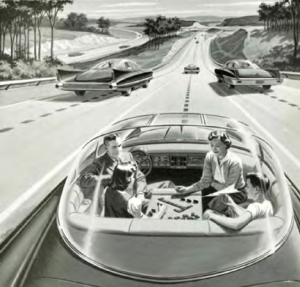In the first two parts of our series covering emerging technologies in logistics, we looked at both 3D printing and UAV machines. Since, Airbus has used a 3D printer to manufacture the majority of an aircraft. Amazon are also furthering their exploration into Drone technology to minimise delivery times. A fast moving landscape incorporates a great many new technologies and in this blog we’re spotlighting driverless vehicles.

The above image is a 1950s advertisement for America’s Electric Light and Power companies. Perhaps this is not worlds away from the way in which driverless technology could be integrated into our road networks (minus the board game, probably). The notion that drivers will be able to authorise their vehicles to navigate the roads for them, leaves excess time in transit to complete other tasks. Thus, productivity is heightened, serving a more efficient supply chain. However, with the driver predictably still needed in the vehicle to combat any errors, many argue that the benefits don’t outweigh the development costs of this technology.
Of course, driverless technology is already present and often integral to manufacture. Transport vehicles in factories do not need drivers. Instead, machines are automated to handle materials accordingly; this has been so for decades. This reality is far from the 1950s commercial. Rather, these machines run relatively slowly and in enclosed areas as reaction time can be slow. Overall this leaves us with a relatively cumbersome system. However, future enhancements are set to revolutionise existing machinery. Taking this technology from the factory, breaching its current limits and making it fit for public roads has been described as the next “evolutionary step” towards a brighter future in distribution.
We’ve taken the advantages and pitfalls of the use of driverless vehicles in logistics to assess to what extent a future of self-driving trucks is likely. This is to assume that the technology will be refined to allow vans, transits, and articulated lorries to self-drive, with full public road access to transport goods.
The benefits
- Similar to UAV technology, human error is scrapped. The prime responsibility now resides with the machinery and this has the potential to minimise road accidents, often a result of driver faults. Road accidents caused by tiredness or lack of attention would no longer be an issue, generating a safer road network.
- Once the driving has been adopted by an automated system, drivers can serve other company duties whilst in the vehicle, such as administrative tasks. This, of course, enhances productivity, saving time, money and resources.
- Current regulations preventing employees from driving around the clock wouldn’t necessarily exist in a realm of self-driving vehicles according to many, therefore supply chain efficiency is heightened significantly.
- In this hypothetical landscape in which vehicles can keep going, transit times will be shorter which, in turn, increases freight turnover. This increase in turnover can be used to improve other areas of a logistics plan, from cutting loading times to expanding marketing budgets.
- Ultra-sensitive reactors would allow vehicles to drive closer together, reducing traffic congestion.
- Driverless vehicles generally have a lower environmental impact.
The assumption has been made that the driver will still need to be present, whether this is to take over should error occur, or serve as a human contact for the company at the pick-up/delivery locations. This point leads us to the downsides of self-driving vehicles in this industry:
The negatives
- In order to be able to take control, should an error occur, the driver on board will need to be a professional. Therefore, full training will still need to be provided in a field which is experiencing a distinctly fewer number of young applicants than ever before.
- In our list of positives, we mentioned round-the-clock driving. However, many argue that this wouldn’t be the case and that the driver would need to remain awake and alert to combat any technical faults. As a result, rest times would realistically remain about the same.
- Conversely, if we were to reach a situation where drivers were not needed, or even if they were to complete other tasks whilst in the vehicle, we have an employment issue. Whether this is a loss of jobs for drivers, or a loss of jobs at the company office(s) because tasks are completed mid-transit.
- At this point we’ve not considered the downside of an automated system inherently. Software can be hacked. If this technology is hacked, people can off-road vehicles, crash them, as well as track home/confidential addresses. Clearly, there is huge chaotic potential here.
The role of the driver seems ironically vital when discussing self-driving vehicles. That is, does said employee need to be present and to what extent? We are clearly far from a road system populated by driverless vehicles, but the question still stands as to how important they will become for the future of logistics?
Perhaps the most likely projection is the existence of manned driverless vehicles. Automated trucks have a smaller environmental impact, can react quicker to dynamic road changes, create a less tiring journey for supervising drivers and reduce traffic congestion. In this sense, they benefit the logistics industry significantly. However, with alert, trained drivers still a necessity, will logistic companies invest in driverless technology for their fleet? If drivers were able to carry out other tasks whilst aboard a vehicle that was more reactive to changes, thus averting collisions, this could conceivably assist the supply chain in becoming safer and more efficient.
How do you see driverless technology shaping the future of logistics? Will it bear much influence at all? Tweet Apollo Cardiff and let us know, @ApolloCardiff. Make sure to use #driverlesstech in your comments!
Thanks to
http://www.iml.fraunhofer.de/en/fields_of_activity/automation_embedded_systems/research/SaLsA.html
file:///C:/Users/owner/Downloads/dhl_self_driving_vehicles.pdf
https://kevingue.wordpress.com/2013/10/05/thoughts-on-driverless-trucks/
http://logisticsviewpoints.com/2015/02/18/are-driverless-trucks-the-solution-to-the-driver-shortage/
https://sites.google.com/a/cortland.edu/driverless-car-torres/disadvantages
Reblogged this on UK Business and Sports News.
LikeLike
Reblogged this on KCJones and commented:
Add Another Follower of UBER
LikeLike